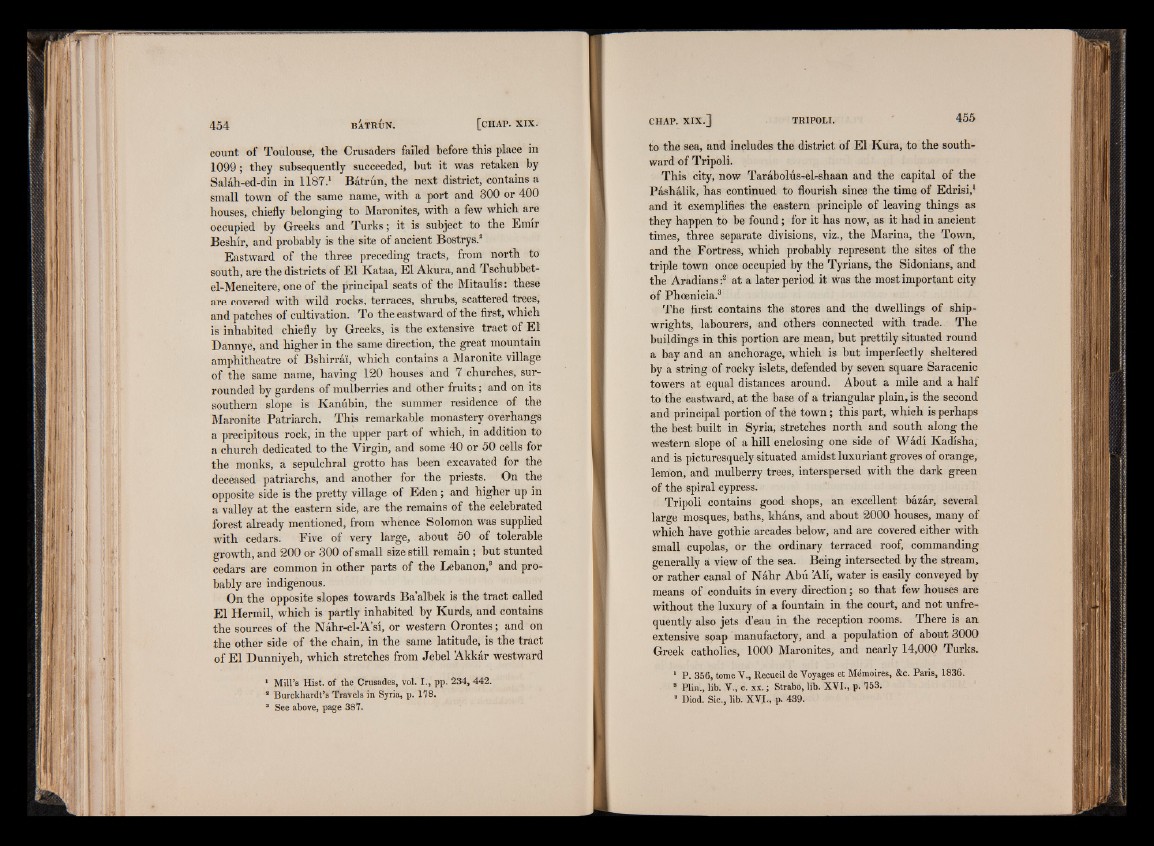
count of Toulouse, the Crusaders failed before this plaee in
1099; they subsequently succeeded, but it was retaken by
Salah-ed-din in 1187.1 Bat.run, the next district, contains a
small town of the same name, with a port and 300 or 400
houses, chiefly belonging to Maronites, with a few which are
occupied by Greeks and Turks; it is subject to the Emir
Beshir, and probably is the site of ancient Bostrys.2
Eastward of the three preceding tracts, from north to
south, are the districts of El Kataa, El Akura, and Tschubbet-
el-Meneitere, one of the principal seats of the Mitaulis: these
are covered with wild rocks, terraces, shrubs, scattered trees,
and patches of cultivation. To the eastward of the first, which
is inhabited chiefly by Greeks, is the extensive tract of El
Dannye, and higher in the same direction, the great mountain
amphitheatre of Bshirrai, which contains a Maronite village
of the same name, having 120 houses and 7 churehes, surrounded
by gardens of mulberries and other fruits; and on its
southern slope is Kanubin, the summer residence of the
Maronite Patriarch. This remarkable monastery overhangs
a precipitous rock, in the upper part of which, in addition to
a church dedicated to the Virgin, and some 40 or 50 cells for
the monks, a sepulchral grotto has been excavated for the
deceased patriarchs, and another for the priests. On the
opposite side is the pretty village of Eden; and higher up in
a valley at the eastern side, are the remains of the celebrated
forest already mentioned, from whence Solomon was supplied
with cedars. Five of very large, about 50 of tolerable
growth, and 200 or 300 of small size still remain; but stunted
cedars are common in other parts of the Lebanon,8 and probably
are indigenous.
On the opposite slopes towards Ba’albek is the tract called
El Hermil, which is partly inhabited by Kurds, and contains
the sources of the Nahr-el-A’si, or western Orontes; and on
the other side of the chain, in the same latitude, is the tract
of El Dunniyeh, which stretches from Jebel Akkar westward
1 Mill’s Hist, of the Crusades, vol. I., pp. 234, 442.
* Burckhardt’s Travels in Syria, p. 118.
3 See above, page 387.
to the sea, and includes the district of El Kura, to the southward
of Tripoli.
This city, now Tarabolus-el-shaan and the capital of the
Pâshâlik, has continued to flourish since the time of Edrisi,1
and it exemplifies the eastern principle of leaving things as
they happen to be found ; for it has now, as it had in ancient
times, three separate divisions, viz., the Marina, the Town,
and the Fortress, which probably represent the sites of the
triple town once occupied by the Tyrians, the Sidonians, and
the Aradians:8 at a later period it was the most important city
of Phoenicia.3
The first contains the stores and the dwellings of shipwrights,
labourers, and others connected with trade. The
buildings in this portion are mean, but prettily situated round
a bay and an anchorage, which is but imperfectly sheltered
by a string of rocky islets, defended by seven square Saracenic
towers at equal distances around. About a mile and a half
to the eastward, at the base of a triangular plain, is the second
and principal portion of the town ; this part, which is perhaps
the best built in Syria, stretches north and south along the
western slope of a hill enclosing one side of W âdi Kadisha,
and is picturesquely situated amidst luxuriant groves of orange,
lemon, and mulberry trees, interspersed with the dark green
of the spiral cypress.
Tripoli contains good shops, an excellent bazar, several
large mosques, baths, khans, and about 2G00 houses, many of
which have gothic arcades below, and are covered either with
small cupolas, or the ordinary terraced roof, commanding
generally a view of the sea. Being intersected by the stream,
or rather canal of Nâhr Abu Ali, water is easily conveyed by
means of conduits in every direction ; so that few houses are
without the luxury of a fountain in the court, and not unfre-
quently also jets d’eau in the reception rooms. There is an
extensive soap "manufactory, and a population of about 3000
Greek catholics, 1000 Maronites, and nearly 14,000 Turks.
1 P. 356, tome V., Recueil de Voyages et Mémoires, &c. Paris, 1836.
* Plin., lib. V., o. xx. ; Strabo, lib. XVI., p. 753.
3 Diod. Sic., lib. XVI., p. 439.